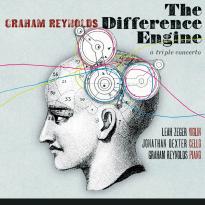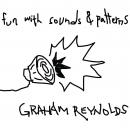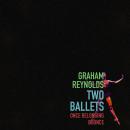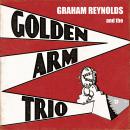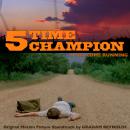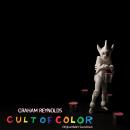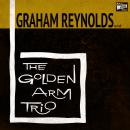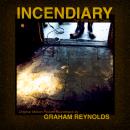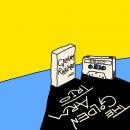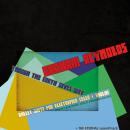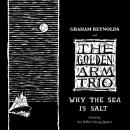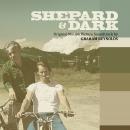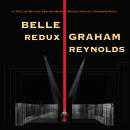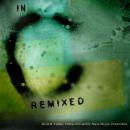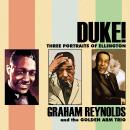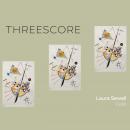The Difference Engine
The Difference Engine
Austin, TX
Graham Reynolds loves to explore narrative in his work. This tendency makes him a natural fit for the film, theater and dance work that form one of the cores to his composing career. In fusing a loose concerto format with the story of Charles Babbage and his invention the difference engine, Reynolds' composing voice finds itself in a work that is intense and driving, beautiful and intimate, personally expressive and broadly accessible all at the same time. Developed over a course of years, the initial ideas for each movement were introduced and inspired separately before being woven into this one piece.
The musical onslaught of the opening movement came to Reynolds during a lecture by LB Deyo on Babbage and his work, inspired by the ferocious pace of both Babbage's thinking and the calculating speed of his invention. The fourth movement was developed in a very different form for the Rude Mechs play "The Method Gun", now touring the country. The fifth movement started as a solo piano piece, an Austin Museum of Art commission, in response to the work of Sol Lewitt. Reynolds joins other alt-classical voices in a 21st century approach that is no longer in rebellion against tonality and melody, nor desperate to prove their validity through focus on a "unique" extended technique, while folding 20th century ideas from clusters to modal harmonies to polyrhythms into a broad vocabulary.
The completed concerto "The Difference Engine" premiered on February 6th, 2010 with a 35-piece string orchestra in a Golden Hornet Project performance at Ballet Austin’s Austin Ventures Studio Theater. Soloists Leah Zeger on violin, Jonathan Dexter on cello, and the composer himself on piano fronted the debut, with parts written specifically for their skill set and personal voices. Those voices were then captured for this CD. Not fully realized in his lifetime, the difference engine was the masterwork of 19th century inventor and mathematician Charles Babbage, an attempt to create the world's first computer. A remix of each movement forms the album's second half with contributions from DJ Spooky, Octopus Project, Grammy-nominated producer Adrian Quesada of Grupo Fantasma, Golden Hornet Project's Peter Stopschinski, and finally one from the composer himself.
BLURT MAGAZINE
"Reynolds … brings out the evocative styles with grace, even when a movement requires sections to repeat several times like a pop song … [The remix] portion of the disc comes off strongly, as a complete part rather than just a repackaging of what was just performed." [FULL ARTICLE]
—Mike Shanley
MUSICWEB INTERNATIONAL
"The Difference Engine is … impressively well written and highly effective. 'The Cogwheel Brain' … sets up a mood of exploratory energy and some unexpected sonorities. Sustained strings give atmosphere to the themes and imitative counterpoint of 'Ada.' The central movement is a potent rhythmic number, with light percussion on the wood of the piano and some off-the-bridge syncopation from the ensemble. "This is another grand release from Innova. I’ve certainly enjoyed entering the world of Graham Reynolds with this release, and will certainly be looking out for his name in future." [FULL ARTICLE]
—Dominy Clements
NEW MUSIC BOX
"Austin, Texas-based composer Graham Reynolds's The Difference Engine: A Triple Concerto does not waste notes getting your attention. A shriek of scraped strings launches a frantic run through the opening moments of this five-movement work … In the 20 minutes of music that follow the high-velocity kick off, The Difference Engine spans moments of beautiful melancholia to coarse, bow-grinding rhythmic churning. That Reynolds is no stranger to composing for theater, dance, and film is evident even in this purely instrumental work. His language here is evocative and direct: It is as if Reynolds is delivering to your ear a mysterious and ambiguous tale in sound—wildly open to interpretation, of course, but it's a page-turner nonetheless. The pace of the first movement, 'The Cogwheel Brain,' glides into the soft reflection of 'Ada.' Delicate piano notes inside a lush string bed of unison playing lead toward moments of mournful solo cello and violin lines. A light blooms in the music as it moves, however, settling into a bittersweet memory of a piece. The muffled tones of a prepared piano and gritty string playing that follow kick the imagery in a new direction for the third movement, 'Cam Stack & Crank Handle.' In contrast with the awesome mechanical rhythms coming out of the ensemble, a secondary theme literally swoops in with an irresistible shoulder-shaking and hip-swaying beat—and enough swagger and glissandi to seduce the house. Reynolds takes another turn toward the quiet in the broad and reflective 'Late at Night/The Astronomer' before launching into the flash of the work's closing movement. Showcasing a similar speed and fire found in showstopper masterpiece cadenzas of many years past, the three soloists are given room to throw down, pausing for only a few moments of thematic respite before they and the chamber players behind them make their wild and full-speed dash for the double bar." [FULL ARTICLE]
—Molly Sheridan
THE INDEPENDENT
"Graham Reynolds is the quintessential modern composer, able to turn his hand to anything from rock to ballet to movie scores to jazz … [The Difference Engine] opens dramatically, with frantic pizzicato and shrill bowing … reaching a vertiginous climax in bold, cinematic style. The more contemplative second movement has echoes of Philip Glass's lyrical minimalism, while the third uses rasping, machine-like bowing beneath a lead line reminiscent of Astor Piazzolla--evidence of the inclusivity that marks Reynolds' approach." [FULL ARTICLE]
—Andy Gill
AMERICAN RECORD GUIDE
"The opening of Graham Reynolds' Difference Engine doesn't hide anything in the background. The short, growing, sliding I [section] is filled with syncopated plucks, rapid notes, and tremendous slides ... The music is urgent like the soundtrack to a daring chase scene with only a fleeting moment of repose that contemplates the distance the piece has traveled before hurtling ahead to the conclusion ... Somehow, the inclusion of the remixes doesn't distract from the actual program and, instead, bolsters it."
—Kraig Lamper
